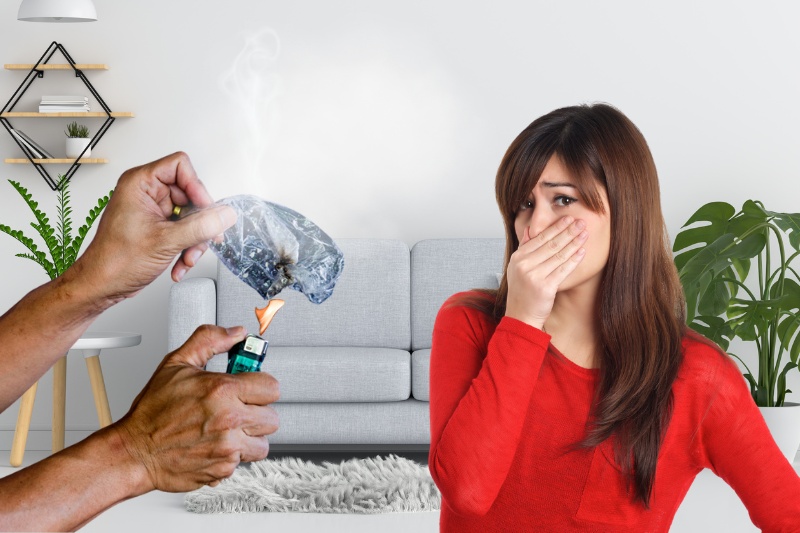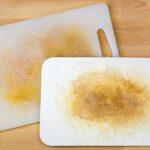Walking into your home and being greeted by the scent of burning plastic can be alarming. The distinctive and unpleasant odour naturally triggers a flurry of questions: What could be causing it? Is it a potential fire hazard? How can you eliminate it?
A house that smells like burning plastic demands immediate attention, as it often signifies underlying issues that need resolving promptly.
Why Does My House Smell Like Burnt Plastic?
If your house smells like burning plastic, it’s usually because something made from plastic is burning!
Plastics are made from polymers that release volatile organic compounds (VOCs) and other substances when they melt.
These various gases and chemicals are responsible for the foul burning smell characteristic of burnt plastic.
Unfortunately, many of these compounds are toxic and bad for our health. Additionally, for plastic to reach its melting point and start to degrade, something is usually overheating to a dangerous point and becoming a fire hazard.
Therefore, a burnt plastic smell in your house is not only extremely unpleasant—it can also be very concerning.
The good news is that you can remove the health risks, fire hazards, and unpleasant odours if you identify the cause. Here we explain the most common ones you might be facing.
1. Electrical issues
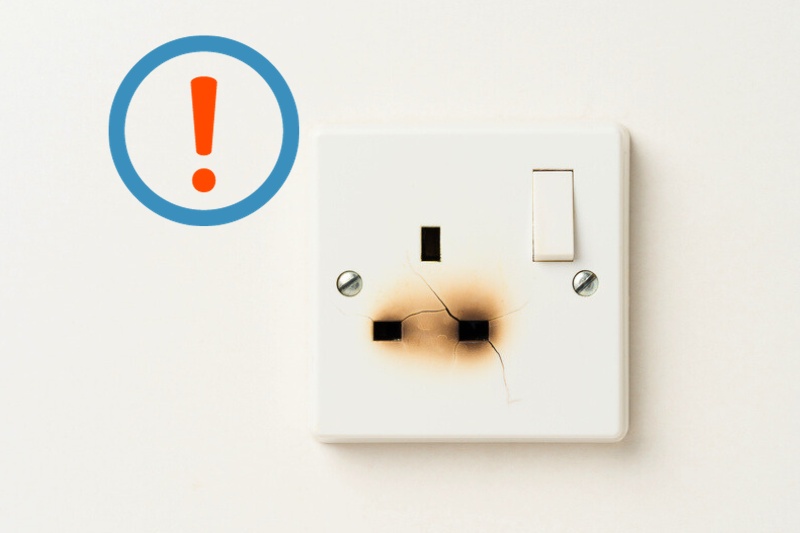
All household appliances as well as the main electricity circuit that powers your home contain plastic components. Wires, cables, insulation and connectors can all have plastic parts.
If these plastic components become damaged or overheat, they can start to melt and emit a horrible burnt plastic smell.
This can potentially cause the appliance to set on fire. Overheating occurs from a range of electrical issues: short circuits, overloaded circuits, or faulty wiring can lead to increased resistance in the electrical system, and resistance generates heat as a byproduct.
As the heat builds up, it can cause the plastic components to melt or become scorched, releasing the characteristic burnt plastic odour.
2. Melted plastic objects

If a plastic object in your home has melted due to high heat, it could release a burnt plastic odour around your house.
This could be anything from a plastic toy left near a heat source to candles catching fire to plastic packaging.
Sometimes, burnt plastic smells can come from cooking accidents, like melted plastic utensils that have been left in hot pans or packaging accidentally dumped on a hot stove.
Similarly, plastic containers put in the oven or microwave can become misshapen and begin releasing the unpleasant burning smell into your home.
3. Heating system malfunctions

Malfunctions in heating systems such as furnaces or space heaters could lead to overheating and produce a burnt plastic smell.
Here is why heating system issues might lead to this particular odour:
- Overheated elements: Heating systems use heating elements to generate warmth. If these elements or the wiring connected to them become damaged or overheated, they can emit a burnt plastic smell as the insulation on wires or nearby plastic components begins to melt.
- Dust accumulation: Dust can accumulate within heating systems, particularly during periods of disuse. When the heating system is next turned on, the accumulated dust can come into contact with hot components and burn, leading to an odour that resembles burnt plastic.
- Faulty components: If any components within the heating system malfunction, such as temperature sensors or control boards, they might cause the system to operate abnormally. This can lead to overheating and the associated burning plastic smell.
5. Insulation or building materials
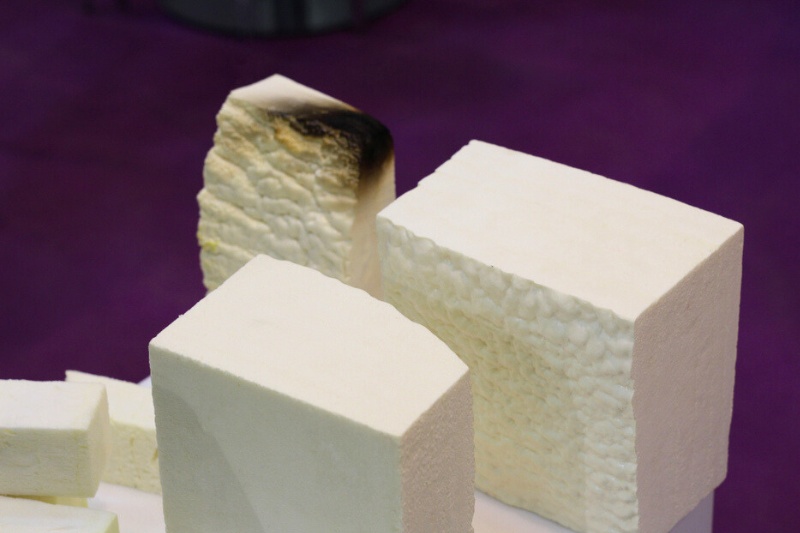
Many building materials and insulation products are made from synthetic materials that contain plastics, polymers, or other organic compounds.
When exposed to high temperatures, these materials can break down and release VOCs that create a burnt plastic smell.
If properly installed, it is rare for these building materials to melt and produce the smell of burning plastic.
However, insulation materials that are installed too close to heating systems, exhaust vents, or electrical components can become exposed to elevated temperatures. The materials then become overheated and emit odours as a result.
6. External sources

If you notice the smell only intermittently, it might be coming from outside your house. Some possible explanations for this include:
- Nearby industrial activity: Industrial facilities, factories, or processing plants in your vicinity might be releasing emissions or fumes that carry a burnt plastic smell. Chemical processes in these facilities can sometimes produce odours that resemble burnt plastic.
- Waste burning: Improper waste disposal, including the burning of plastic materials, can generate a strong burnt plastic odour in the air. This could happen in nearby areas, especially if waste is being burned openly or inappropriately.
- Transportation: Vehicles on the road can emit smells that resemble burnt plastic due to engine issues, overheating, or exhaust emissions. If something plastic inside a vehicle comes loose and falls into an area where heat is generated, it can also melt and start to smell.
7. Mould or mildew growth
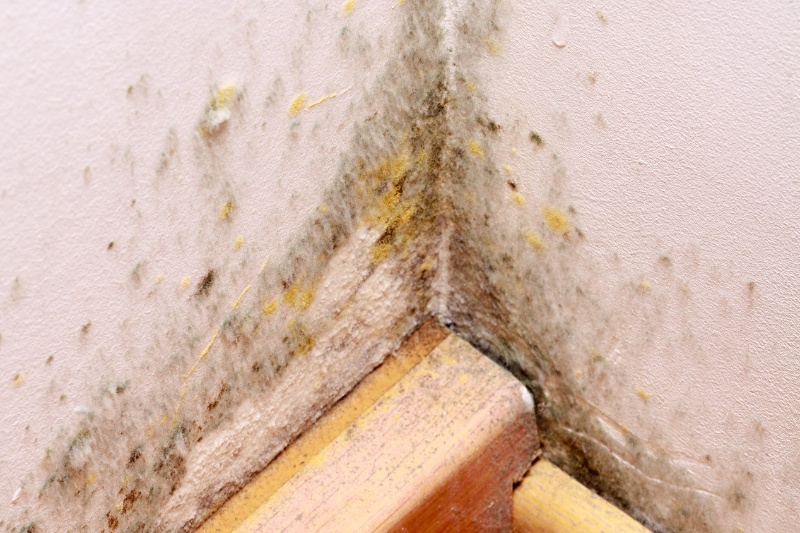
Mould and mildew do not typically smell like burning plastic. However, they can emit musty, earthy, or damp odours.
These smells come from alcohols, aldehydes, and other organic molecules that are byproducts of their metabolic processes, released by the mould during growth and reproduction.
Importantly, the perception of these odours can vary from person to person, and the descriptions people use to describe them might differ as well.
Therefore, you may perceive the smell of mould to resemble that of burning plastic in your house.
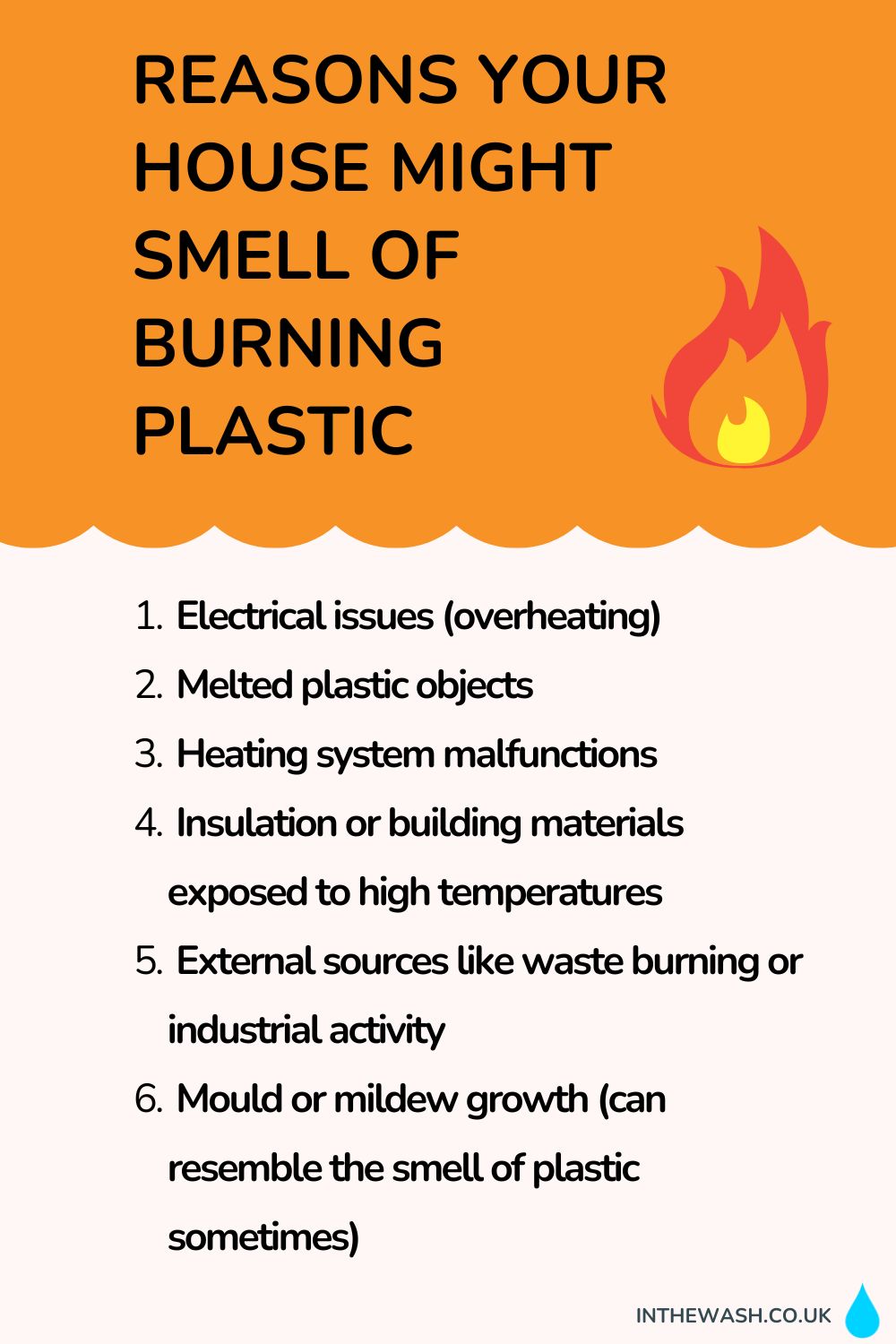
What Should I Do If I Smell Burning Plastic in My House?
If you detect a strong and persistent smell of burning plastic in your house, it’s essential to take immediate action to ensure your safety and address the potential source of the odour.
This helps to protect you against any possible health consequences and prevents other hazardous eventualities, such as household fires.
Here’s what you should do:
Step 1: Always put your safety first
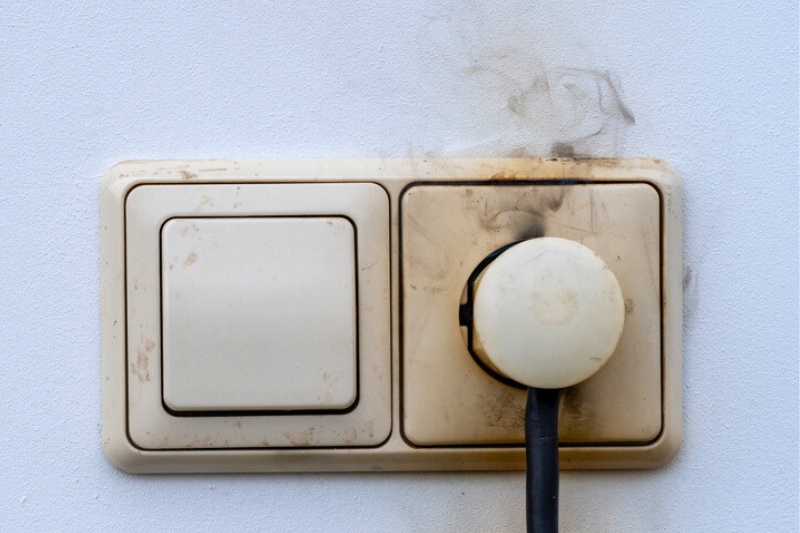
If you suspect an electrical issue, potential fire hazard, or any other serious problem, prioritise your safety and the safety of your household members.
If the smell is accompanied by smoke, visible damage, or a feeling of danger, leave your house immediately and call emergency services (fire department) from a safe location.
Step 2: Find the source of the burning plastic smell

If you believe the situation is safe, carefully investigate the source of the smell. Start by determining the general area where the scent is the strongest.
Walk around your house following your nose and note the specific rooms or areas with the most intense smell.
Once you have narrowed down the room, follow the below steps:
- Check electrical outlets: Begin by inspecting electrical outlets, switches, and nearby appliances. Check for signs of damage, overheating, or melted plastic, including damaged cables, cords, and plugs. Extension leads in particular can easily become overloaded and start to overheat.
- Examine your heating systems: Examine your heating systems (furnaces, space heaters, and radiators) for signs of overheating. Check vents and ducts for any debris or obstructions and look for signs of malfunction.
- Check your devices: Inspect any electronic devices, chargers, and power strips to see if the smell is coming from them. Sometimes electronics can emit a plastic-like smell if they’re malfunctioning or overheating.
- Look for melted plastic items: Verify that no plastic utensils, containers, or packaging have accidentally been left on a stove, in an oven, or near a hot surface. You should also check around radiators and other heat sources.
- Examine your furniture: Lastly, look at any furniture, decorations, or household items in the area where the smell is most potent. Some furnishings or objects might contain plastic components that have melted.
Step 3: Turn off the power
Turn off the power to whatever is producing the excess heat. For example:
- Unplug or turn off any appliances emitting the smell to prevent the electrical components from overheating further. Wait for them to cool down if needed, then examine the appliance thoroughly to find the precise location of the melted plastic. If the device is in good working condition, the smell might be coming from the outlet.
- If the smell seems to be coming from an electrical source, consider turning off the power to the affected area or the entire house to prevent potential electrical fires. Do this only if you can do so safely. If at any point you notice visible damage, sparking, or any other signs of potential danger, consider contacting emergency services if necessary.
- For more minor issues (such as melted plastic from cooking accidents), ensure the stove, microwave, or any other heat source is turned off. Move the melted plastic utensils or packaging to a cool location, ideally outside of your home, to prevent more toxic fumes from entering the air inside your house.
Step 4: Open windows and deodorise the air

Open windows and doors to allow fresh air to circulate around your home. This dissipates the burning odour and any toxic fumes.
You can also use fans or other means of ventilation to help if necessary. For example, consider placing air purifiers in affected areas or rooms with poor ventilation.
Placing bowls of bicarbonate of soda (also known as baking soda) in the affected rooms can also help to deodorise the space and make your home smell nice.
Bicarbonate of soda absorbs smells from the air rather than masking them as many air fresheners or scented candles do.
Leave the bowls uncovered for a few days, and the burning plastic smell should noticeably start to fade.
Step 5: Clean the area
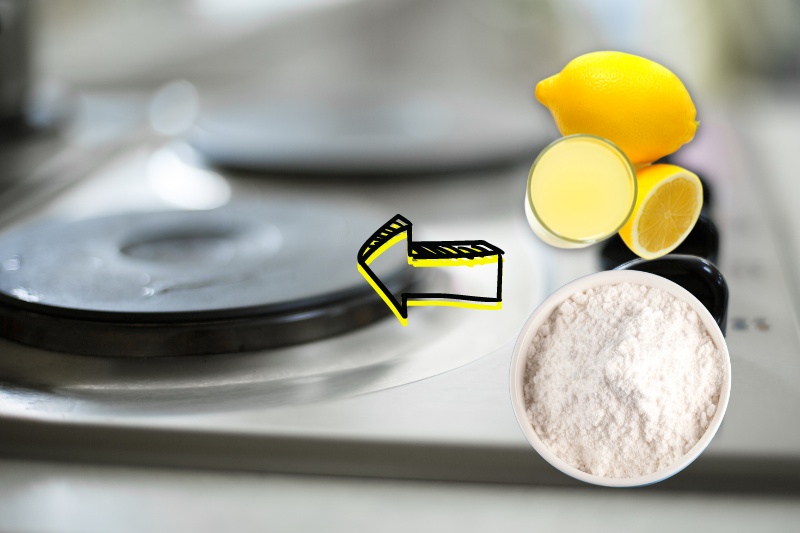
You must thoroughly clean the affected area to remove any residues that might be contributing to the smell.
Ensure you use appropriate cleaning products and methods based on the type of surface.
You can purchase specialist cleaners designed for use on the surface you’re working with or DIY cleaners made from everyday household items.
For example, burnt plastic on electric hob solid plates can be cleaned using bicarbonate of soda and either lemon juice, white vinegar, or washing-up liquid.
Induction hobs can also be cleaned using these methods. In fact, using bicarbonate of soda is a fantastic option for eliminating smells, thanks to its odour-absorbing properties.
Step 6: Wash soft furnishings that smell
Many soft furnishings (curtains, cushions, carpets, etc.) may have absorbed the smell of burning plastic.
To properly eliminate the unpleasant odour, these too have to be cleaned effectively. Always wash or clean them according to their care label instructions to avoid potential damage.
Tip: Our page on the best carpet deodorisers might be helpful for this.
Step 7: Contact professionals if needed
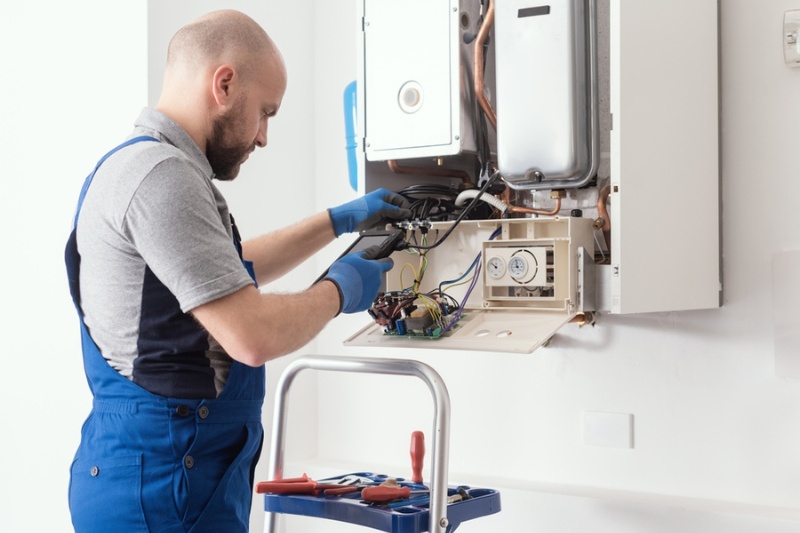
If you can’t identify or resolve the issue on your own, seeking professional assistance is recommended. Here is the best person to contact depending on the cause at hand:
- Electrical issues: If you suspect an electrical problem, contact a licensed electrician to inspect and address the issue.
- Heating systems: If the smell is related to your heating system, contact an HVAC technician to assess and repair any malfunctions.
- Household appliances: If a specific appliance is emitting the smell, consider having it inspected by a professional technician.
Remember that your safety is paramount. If you’re uncertain about the situation or feel that it’s beyond your control, don’t hesitate to contact emergency services, too.
It’s always better to be cautious and proactive when dealing with potential fire hazards or electrical issues.
Step 7: Monitor the situation

After taking initial steps, continue to monitor the situation. If the smell persists or worsens, or if you notice any other concerning symptoms (e.g., flickering lights, unusual noises), take further action as needed—this usually entails calling a professional.
It’s also a good idea to document the situation, including any visible damage, unusual behaviour of appliances or electronics, and the steps you’ve taken to address the issue. This information can be helpful if you need to involve professionals or insurance later.

Hannah has a passion for cleaning. She worked her way around Australia by cleaning hostels in exchange for free accommodation and used her cleaning skills to bag a job as a chalet host for a luxury ski company in France.
